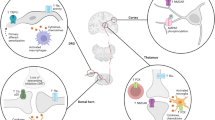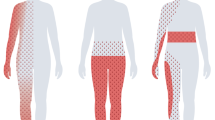Abstract
Central neuropathic pain (CNP) from injury to the central somatosensory pathways can be difficult to treat. Of the treatments generally considered front-line for neuropathic pain, pregabalin is useful for treating spinal cord injury-related CNP and duloxetine for multiple sclerosis-related CNP. There is also weak evidence supporting amitriptyline and gabapentin use for CNP. A number of other treatment approaches show some promise in a small number of studies but require further investigation.
Similar content being viewed by others
References
Gurba KN, Chaudhry R, Haroutounian S. Central neuropathic pain syndromes: current and emerging pharmacological strategies. CNS Drugs. 2022;36(5):483–516.
Bates D, Schultheis BC, Hanes MC, et al. A comprehensive algorithm for management of neuropathic pain. Pain Med. 2019;20(Suppl 1):1–12.
Greater Manchester Medicines Management Group. Neuropathic pain in adults - guideline for primary care (March 22, version 8.2). 2022. https://gmmmg.nhs.uk. Accessed 27 Oct 2022.
Schlereth T. Guideline “diagnosis and non interventional therapy of neuropathic pain” of the German Society of Neurology (deutsche Gesellschaft fur Neurologie). Neurol Res Pract. 2020;2:16.
Giovannini S, Coraci D, Brau F, et al. Neuropathic pain in the elderly. Diagnostics (Basel). 2021;11(4):613.
Onder G, Giovannini S, Sganga F, et al. Interactions between drugs and geriatric syndromes in nursing home and home care: results from Shelter and IBenC projects. Aging Clin Exp Res. 2018;30(9):1015–21.
Staudt MD, Clark AJ, Gordon AS, et al. Long-term outcomes in the management of central neuropathic pain syndromes: a prospective observational cohort study. Can J Neurol Sci. 2018;45(5):545–52.
Leijon G, Boivie J. Central post-stroke pain–a controlled trial of amitriptyline and carbamazepine. Pain. 1989;36(1):27–36.
Kim NY, Lee SC, Kim YW. Effect of duloxetine for the treatment of chronic central poststroke pain. Clin Neuropharmacol. 2019;42(3):73–6.
Shimodozono M, Kawahira K, Kamishita T, et al. Reduction of central poststroke pain with the selective serotonin reuptake inhibitor fluvoxamine. Int J Neurosci. 2002;112(10):1173–81.
Hesami O, Gharagozli K, Beladimoghadam N, et al. The efficacy of gabapentin in patients with central post-stroke pain. Iran J Pharm Res. 2015;14(Suppl):95–101.
Levendoglu F, Ogun CO, Ozerbil O, et al. Gabapentin is a first line drug for the treatment of neuropathic pain in spinal cord injury. Spine (Phila Pa 1976). 2004;29(7):743–51.
To TP, Lim TC, Hill ST, et al. Gabapentin for neuropathic pain following spinal cord injury. Spinal Cord. 2002;40(6):282–5.
Tai Q, Kirshblum S, Chen B, et al. Gabapentin in the treatment of neuropathic pain after spinal cord injury: a prospective, randomized, double-blind, crossover trial. J Spinal Cord Med. 2002;25(2):100–5.
Houtchens MK, Richert JR, Sami A, et al. Open label gabapentin treatment for pain in multiple sclerosis. Mult Scler. 1997;3(4):250–3.
Kalita J, Chandra S, Misra UK. Pregabalin and lamotrigine in central poststroke pain: a pilot study. Neurol India. 2017;65(3):506–11.
Onouchi K, Koga H, Yokoyama K, et al. An open-label, long-term study examining the safety and tolerability of pregabalin in Japanese patients with central neuropathic pain. J Pain Res. 2014;7:439–47.
Rintala DH, Holmes SA, Courtade D, et al. Comparison of the effectiveness of amitriptyline and gabapentin on chronic neuropathic pain in persons with spinal cord injury. Arch Phys Med Rehabil. 2007;88(12):1547–60.
Cardenas DD, Warms CA, Turner JA, et al. Efficacy of amitriptyline for relief of pain in spinal cord injury: results of a randomized controlled trial. Pain. 2002;96(3):365–73.
Vranken JH, Hollmann MW, van der Vegt MH, et al. Duloxetine in patients with central neuropathic pain caused by spinal cord injury or stroke: a randomized, double-blind, placebo-controlled trial. Pain. 2011;152(2):267–73.
Brown TR, Slee A. A randomized placebo-controlled trial of duloxetine for central pain in multiple sclerosis. Int J MS Care. 2015;17(2):83–9.
Vollmer TL, Robinson MJ, Risser RC, et al. A randomized, double-blind, placebo-controlled trial of duloxetine for the treatment of pain in patients with multiple sclerosis. Pain Pract. 2014;14(8):732–44.
Vranken JH, Dijkgraaf MG, Kruis MR, et al. Pregabalin in patients with central neuropathic pain: a randomized, double-blind, placebo-controlled trial of a flexible-dose regimen. Pain. 2008;136(1–2):150–7.
Siddall PJ, Cousins MJ, Otte A, et al. Pregabalin in central neuropathic pain associated with spinal cord injury: a placebo-controlled trial. Neurology. 2006;67(10):1792–800.
Cardenas DD, Nieshoff EC, Suda K, et al. A randomized trial of pregabalin in patients with neuropathic pain due to spinal cord injury. Neurology. 2013;80(6):533–9.
Kim JS, Bashford G, Murphy KT, et al. Safety and efficacy of pregabalin in patients with central post-stroke pain. Pain. 2011;152(5):1018–23.
Vestergaard K, Andersen G, Gottrup H, et al. Lamotrigine for central poststroke pain: a randomized controlled trial. Neurology. 2001;56(2):184–90.
Finnerup NB, Sindrup SH, Bach FW, et al. Lamotrigine in spinal cord injury pain: a randomized controlled trial. Pain. 2002;96(3):375–83.
Silver M, Blum D, Grainger J, et al. Double-blind, placebo-controlled trial of lamotrigine in combination with other medications for neuropathic pain. J Pain Symptom Manag. 2007;34(4):446–54.
Yang ML, Li JJ, So KF, et al. Efficacy and safety of lithium carbonate treatment of chronic spinal cord injuries: a double-blind, randomized, placebo-controlled clinical trial. Spinal Cord. 2012;50(2):141–6.
Norrbrink C, Lundeberg T. Tramadol in neuropathic pain after spinal cord injury: a randomized, double-blind, placebo-controlled trial. Clin J Pain. 2009;25(3):177–84.
Wilsey B, Marcotte TD, Deutsch R, et al. An exploratory human laboratory experiment evaluating vaporized cannabis in the treatment of neuropathic pain from spinal cord injury and disease. J Pain. 2016;17(9):982–1000.
Langford RM, Mares J, Novotna A, et al. A double-blind, randomized, placebo-controlled, parallel-group study of THC/CBD oromucosal spray in combination with the existing treatment regimen, in the relief of central neuropathic pain in patients with multiple sclerosis. J Neurol. 2013;260(4):984–97.
Rog DJ, Nurmikko TJ, Friede T, et al. Randomized, controlled trial of cannabis-based medicine in central pain in multiple sclerosis. Neurology. 2005;65(6):812–9.
Sakurai M, Kanazawa I. Positive symptoms in multiple sclerosis: their treatment with sodium channel blockers, lidocaine and mexiletine. J Neurol Sci. 1999;162(2):162–8.
Han ZA, Song DH, Oh HM, et al. Botulinum toxin type A for neuropathic pain in patients with spinal cord injury. Ann Neurol. 2016;79(4):569–78.
Amr YM. Epidural ketamine in post spinal cord injury-related chronic pain. Anesth Essays Res. 2011;5(1):83–6.
Rintala DH, Fiess RN, Tan G, et al. Effect of dronabinol on central neuropathic pain after spinal cord injury: a pilot study. Am J Phys Med Rehabil. 2010;89(10):840–8.
Liampas A, Velidakis N, Georgiou T, et al. Prevalence and management challenges in central post-stroke neuropathic pain: a systematic review and meta-analysis. Adv Ther. 2020;37(7):3278–91.
Zhang X, Zhu H, Tao W, et al. Motor cortex stimulation therapy for relief of central post-stroke pain: a retrospective study with neuropathic pain symptom inventory. Stereotact Funct Neurosurg. 2018;96(4):239–43.
Viswanath O, Urits I, Burns J, et al. Central neuropathic mechanisms in pain signaling pathways: current evidence and recommendations. Adv Ther. 2020;37(5):1946–59.
Author information
Authors and Affiliations
Corresponding author
Ethics declarations
Funding
The preparation of this review was not supported by any external funding.
Authorship and conflict of interest
S. Fung and C. Kang are salaried employees of Adis International Ltd/Springer Nature and declare no relevant conflicts of interest. All authors contributed to the review and are responsible for the article content.
Ethics approval, consent to participate, consent for publication, availability of data and material, code availability
Not applicable.
Rights and permissions
Springer Nature or its licensor (e.g. a society or other partner) holds exclusive rights to this article under a publishing agreement with the author(s) or other rightsholder(s); author self-archiving of the accepted manuscript version of this article is solely governed by the terms of such publishing agreement and applicable law.
About this article
Cite this article
Fung, S., Kang, C. Management of central neuropathic pain involves many drugs but few have proven efficacy. Drugs Ther Perspect 39, 1–7 (2023). https://doi.org/10.1007/s40267-022-00965-z
Accepted:
Published:
Issue Date:
DOI: https://doi.org/10.1007/s40267-022-00965-z




